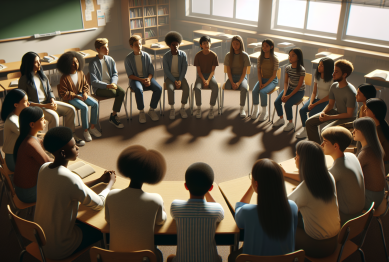In education, the goal is not just to impart knowledge but to ensure that learning sticks. A “sticky” learning environment is one where students don’t just absorb information temporarily but engage deeply and retain it over time. In the rapidly changing landscape of education, especially with the advent of new technologies and teaching methods, creating a learning environment that fosters long-term retention is more crucial than ever.
But what makes a learning environment “sticky”? Why do some students thrive in certain settings while others struggle? The answer lies in a combination of factors—ranging from the physical environment and the integration of technology to the pedagogical strategies employed. In this article, we explore the elements that contribute to making a learning environment sticky, the emerging trends in education that support this, and how educators can adapt their methods to enhance student engagement and retention.

What is a ‘Sticky’ Learning Environment?
A sticky learning environment is one that encourages deep, meaningful engagement with the material, enabling students to connect with the content, apply it in real-world scenarios, and retain it over time. This environment goes beyond rote memorization or passive learning. It involves active participation, emotional engagement, and critical thinking. Here are the key characteristics of a sticky learning environment:
-
Engagement: Students are not just listening; they are actively involved in the learning process.
-
Relevance: The content feels meaningful to students, relating to their interests, goals, or real-life situations.
-
Active Learning: Students are encouraged to apply, analyze, and synthesize information rather than passively receive it.
-
Emotional Connection: The material resonates with students on an emotional level, making it more likely to be remembered.
-
Feedback and Reflection: Students are given regular feedback and opportunities to reflect on their learning.
Key Factors That Make a Learning Environment Sticky
1. Interactivity and Student-Centered Learning
In traditional education models, students are often passive recipients of information. However, a sticky learning environment flips this dynamic. Active learning, where students engage in problem-solving, discussions, or projects, leads to higher retention rates. Studies have shown that students who engage with content through interactive activities like debates, group work, or hands-on experiments remember the material better than those who are merely lectured to.
-
Example: In project-based learning, students work on real-world problems that require critical thinking and collaboration. These types of environments make learning feel relevant and allow students to apply what they’ve learned, which helps make the material “stick.”
Transition: Interactive environments also make use of modern technology to further engage students.
2. Technology Integration: Enhancing the Learning Experience
The integration of technology in education has the potential to make learning more engaging and accessible. Educational technologies like learning management systems (LMS), interactive whiteboards, and virtual simulations can create immersive environments that keep students engaged. The use of technology also allows for more personalized learning, catering to individual students’ needs and learning speeds.
-
Example: Platforms like Kahoot and Quizlet make learning fun by turning review sessions into games. This gamification keeps students motivated and reinforces learning through repetition and competition, ensuring information retention.
-
Benefit: EdTech platforms such as Coursera and Duolingo have made education accessible to millions worldwide. These platforms incorporate interactive tools and progress tracking to keep students engaged and help them see the real-world value of their learning.
Transition: While technology plays a significant role, another critical factor for making learning sticky is creating an environment that promotes social interaction.
3. Social Learning and Collaborative Environments
Learning is not a solitary activity. Research from the University of Michigan shows that students who collaborate with peers have better learning outcomes and deeper retention. Collaborative environments encourage students to engage with one another, share insights, and challenge ideas. This fosters a sense of community and belonging, which further supports retention.
-
Example: Group projects, study groups, and peer reviews allow students to engage with the material from different perspectives, helping them internalize and retain the content. This social learning aspect adds another layer of depth to their understanding.
-
Benefit: Social interaction not only improves cognitive skills but also builds emotional intelligence, teaching students how to communicate, negotiate, and collaborate—skills that are highly valued in today’s workforce.
Transition: A sticky learning environment also requires a supportive culture where students feel safe to take risks and make mistakes.
4. Psychological Safety and a Growth Mindset
Students are more likely to take risks and engage deeply in their learning when they feel psychologically safe. According to research by Carol Dweck, a growth mindset—the belief that abilities can be developed through hard work and dedication—promotes resilience and persistence, two key factors for long-term retention.
-
Example: Teachers who foster a growth mindset by praising effort over innate ability create an environment where students are not afraid to make mistakes. Mistakes become opportunities for learning, rather than signs of failure, which encourages students to stay engaged and try again.
-
Benefit: When students feel that they can improve through effort, they are more likely to take on challenges, leading to deeper engagement with the material and improved retention.
Transition: Beyond emotional safety, the physical design of a classroom or learning space also plays a significant role in how sticky a learning environment can be.
The Role of the Physical Learning Environment
1. Designing Spaces for Focus and Creativity
The layout of a classroom or learning space can significantly impact a student’s ability to focus and engage. In traditional classrooms, rows of desks facing forward limit collaboration and interaction. However, flexible seating arrangements, comfortable environments, and multi-functional spaces are gaining popularity because they promote collaboration and creativity.
-
Example: Many modern schools are adopting open-plan classrooms, with movable desks and breakout spaces. This setup encourages students to collaborate and allows for more dynamic, interactive learning experiences.
-
Benefit: Natural light, quiet zones, and comfortable furniture can reduce stress and improve focus. When students feel physically comfortable and supported, they are better able to engage with the content and retain the information.
Creating a Sticky Learning Environment: Practical Tips for Educators
1. Incorporate Active Learning Techniques
Encourage students to move beyond passive learning by incorporating active techniques like problem-solving, role-playing, and debates into your lessons. Use tools like Think-Pair-Share and Jigsaw to promote collaboration.
2. Foster a Growth Mindset
Create a classroom culture that values effort, resilience, and improvement. Encourage students to take risks and view mistakes as opportunities for growth.
3. Integrate Technology Thoughtfully
Use technology not only to deliver content but to create interactive, engaging learning experiences. Tools like virtual simulations, gamified learning platforms, and collaborative software can enhance engagement and retention.
4. Encourage Peer-to-Peer Learning
Promote collaborative learning through group projects, peer reviews, and discussions. This approach enhances retention by allowing students to learn from each other and deepen their understanding of the material.
5. Design Learning Spaces with Flexibility in Mind
Ensure that your classroom environment supports the learning activities you want to foster. Use flexible seating, access to technology, and spaces that encourage collaboration to enhance the learning experience.
Conclusion
In the modern age of education, making learning “sticky” is about more than just keeping students entertained; it’s about fostering an environment that deeply engages students and makes the learning process more meaningful. Whether it’s through technology, active learning strategies, or creating supportive and flexible environments, educators have more tools than ever to enhance student retention.
As the educational landscape continues to evolve, creating sticky learning environments will be key to ensuring that students not only learn but retain and apply the knowledge they acquire. By focusing on engagement, emotional connection, and a culture of growth, we can build learning environments that truly make a lasting impact on students’ lives.
Reference
1. Active Learning Enhances Student Performance- https://en.wikipedia.org
2. Technology Integration Supports Engaged Learning- https://www.edutopia.org
3. Experiential Learning Promotes Real-World Application- https://timesofindia.indiatimes.com









